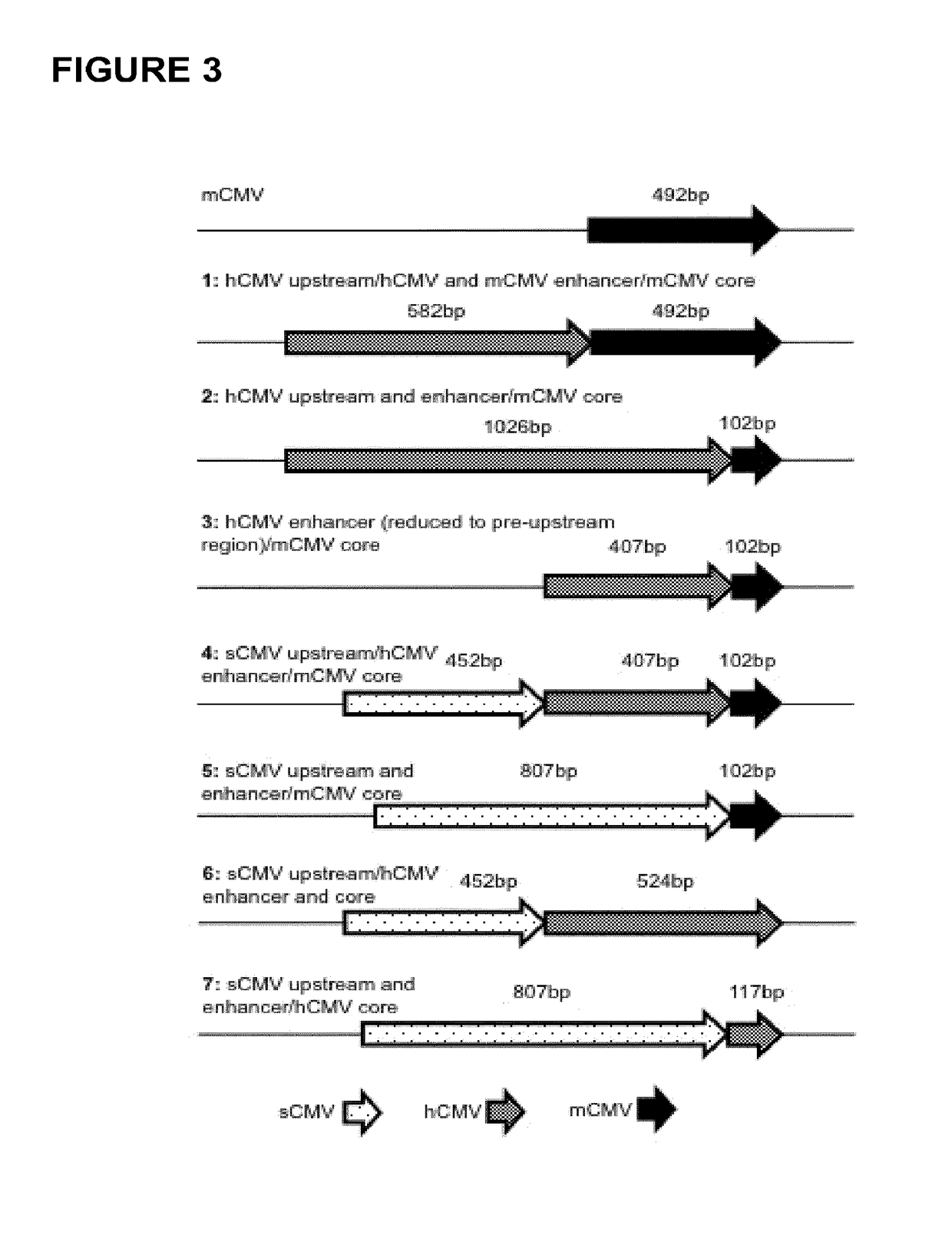Expression vectors comprising chimeric cytomegalovirus promoter and enhancer sequences
a technology of chimeric cytomegalovirus and promoter sequence, which is applied in the field of mammalian expression systems, can solve the problems of high product yield, difficult culture of lymphoid cells at an industrial scale, and the pronounced species specificity of the use of hcmv ie1 and ie2
- Summary
- Abstract
- Description
- Claims
- Application Information
AI Technical Summary
Benefits of technology
Problems solved by technology
Method used
Image
Examples
example 1
nstruction
[0116]Gene synthesis was used to generate the seven different chimeric promoter regulatory constructs employed herein (i.e. constructs “1-7”). The constructs were provided ready for cloning into the “empty” targeting vector pRY42 (cf. FIG. 1, SEQ ID NO: 1), in order to replace the original murine cytomegalovirus (mCMV) promoters (SEQ ID NO: 3) contained therein. Parent vector pRY42 comprises two expression cassettes, each under the control of a promoter regulatory sequence (originally derived from mCMV).
[0117]The chimeric constructs (cf. Table 1, FIG. 3, SEQ ID NO: 7 to SEQ ID NO: 13) were synthesized to include additional DNA sequences at the 5′ and 3′ ends flanking the promoter regulatory sequences, thus allowing for the incorporation of endonuclease restriction sites (i.e. also present in pRY42) in order to facilitate exchange of nucleic acid fragments.
[0118]Table 1 illustrates the various sequence elements comprised in the chimeric promoter regulatory constructs 1-7 em...
example 2
ion and Cell Line Construction
[0123]A cell line derived from suspension adapted Chinese hamster ovary cell line CHOK1SV was used for all experiments (Lonza Ltd., Basel, Switzerland). In this cell line, nucleic acid expression constructs are inserted at a specific genomic locus of the host cell and in defined copy number by means of a site-specific integration (SSI) system.
[0124]Positive selection for integration is accomplished by functional restoration of a hygromycin B resistance cassette present at the SSI site. Integration of the expression construct into the host genome also removes a copy of the thymidine kinase gene, which converts the pro-drug ganciclovir into a toxic, phosphorylated nucleotide analogue. Thus, addition of hygromycin B and ganciclovir during cell line construction provides positive and negative selection pressures, respectively, for integration at the target genomic locus.
[0125]The host cell line was revived from cryopreserved vials and sub-cultured. All cell...
example 3
Overgrow (FOG) Suspension Culture for Determining the Concentration of Monoclonal Antibody Produced by Using “Promoter Constructs 1-5”
[0129]Fed batch overgrow (FOG) shake flask analysis was performed as described in international patent publication WO 2008 / 148519 A2. All FOG experiments for a given transfected cell suspension culture were performed at least in duplicate.
[0130]In brief, transfected cells were seeded at a concentration of 2×105 cells / ml in 250 ml shake flasks, each containing 50 ml of CM42 / SPE growth medium (Lonza Ltd., Basel, Switzerland) and incubated at 37° C. in a humidified orbital shaking incubator (5% (v / v) CO2 in air) at 140 rpm. Cells were fed, starting on day 3 of the culture, with a feed consisting of mixture of amino acids and trace elements. Daily viabilities and viable cell concentrations were determined using a Cedex Automated Cell Viability Analyzer (Roche Diagnostics GmbH, Mannheim, Germany). Antibody concentration in the medium was determined by Prot...
PUM
 Login to View More
Login to View More Abstract
Description
Claims
Application Information
 Login to View More
Login to View More - R&D
- Intellectual Property
- Life Sciences
- Materials
- Tech Scout
- Unparalleled Data Quality
- Higher Quality Content
- 60% Fewer Hallucinations
Browse by: Latest US Patents, China's latest patents, Technical Efficacy Thesaurus, Application Domain, Technology Topic, Popular Technical Reports.
© 2025 PatSnap. All rights reserved.Legal|Privacy policy|Modern Slavery Act Transparency Statement|Sitemap|About US| Contact US: help@patsnap.com



